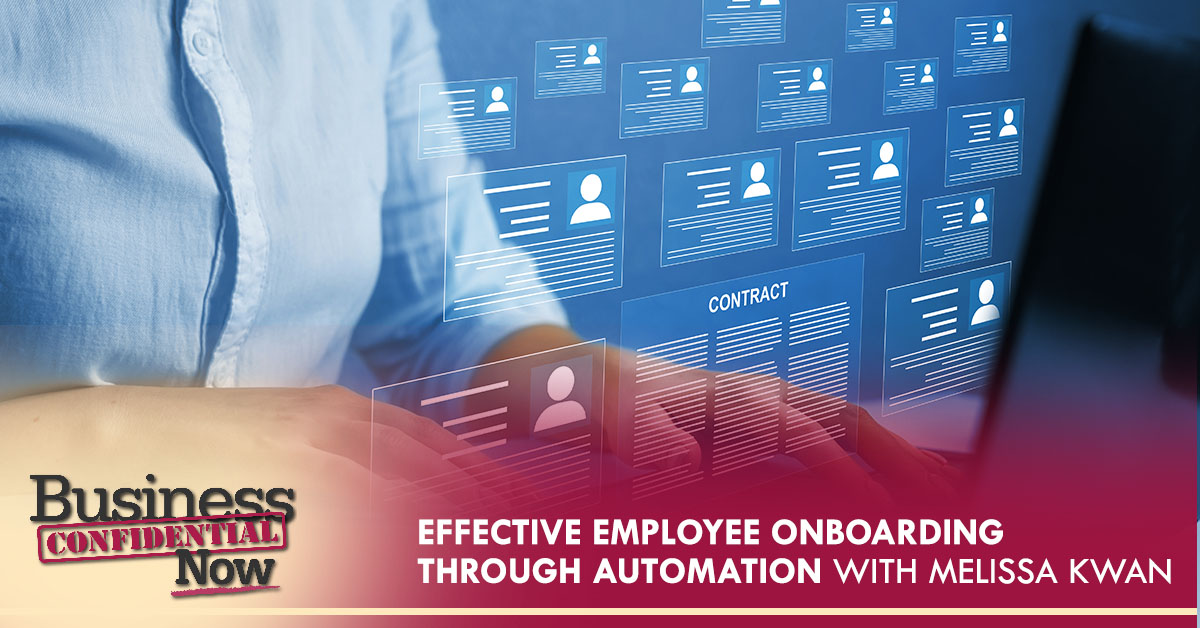
Photo Credit: © iStock | Galeanu Mihai
Employee onboarding is a vital first step for employees in any company. How do we make sure that it’s effective every time without making it a soul-crushing experience for the HR staff? In this episode, Hanna Hasl-Kelchner sits down with eWebinar Cofounder and CEO, Melissa Kwan to talk about how and why they’re providing a platform for businesses to automate their onboarding process. Melissa created this solution after her own experience giving the same webinar over and over and over again. Now, she is on a mission to give others back their time by automating these repetitive webinars. Learn about the benefits of this process and the many use cases of automated trainings for your business. Stay tuned!
—
What You’ll Discover About Effective Employee Onboarding:
- Benefits of automation for the employee
- Why automating employee onboarding is more effective
- Other ways to personalize the onboarding process
- How you can elevate the automated process and collect data
- The importance of delivery and content versus duration of webinars
- Other employee training programs that can use automated webinar technology
- Other use cases of automated webinar technology outside of human resources
The benefits of automated webinars versus live webinars
—
—
Guest
 eWebinar Cofounder and CEO, Melissa Kwan, has spent twelve years in startups and built three successful companies without venture capital backing. Her previous startup, a real estate tech company, was acquired in 2019. As a revenue-driven founder specializing in sales and business development, she has learned how to build companies with very few resources — by automating what she could, outsourcing wherever possible, and inspiring talented people to join her team with shared focus and enthusiasm.
eWebinar Cofounder and CEO, Melissa Kwan, has spent twelve years in startups and built three successful companies without venture capital backing. Her previous startup, a real estate tech company, was acquired in 2019. As a revenue-driven founder specializing in sales and business development, she has learned how to build companies with very few resources — by automating what she could, outsourcing wherever possible, and inspiring talented people to join her team with shared focus and enthusiasm.
Over the last decade, Melissa has come to believe that happiness should be the foundation of one’s career, not the other way around, and that the way to achieve this is by intentionally designing one’s life. This belief was born in part from the soul-crushing experience Melissa endured giving the same webinar over and over again while onboarding and training customers for her previous SaaS company. She wanted to free others from the same trap by giving them a way to automate their repetitive webinars, so they could get their time back and spend it doing something else they value more instead of being tied to Zoom all the time.
—
Effective Employee Onboarding Through Automation With Melissa Kwan
Effective employee onboarding has been said to lead to better employee performance and who doesn’t want that? How do you make employee onboarding more effective? Welcome to the show. Our guest is Melissa Kwan, the Cofounder, and CEO of eWebinar. She’s a great guest and had an amazing experience with employee onboarding.
She says it was a soul-crushing experience because she gave the same webinar over and over again while onboarding and training customers for a previous employer. That inspired her to free others up from the same trap by giving them a way to automate repetitive webinars so they could get back some of their time and their productivity and spend it on doing things that are more valuable to them. I’m looking forward to learning more about how automation makes onboarding new employees more effective. Welcome to the show, Melissa.
Thanks for having me, Hannah.
I love that you are on a mission to give people back their time through automation. Employee onboarding is such an important moment in time for a new employee. They are fragile. They are not quite sure what’s going on. They are excited about the opportunity. I appreciate that automation makes it easier for the trainer but what about the new employee? What advantage is there for the employee?
Number one, maybe this isn’t always automation and for everybody. If your company is small, for example, when you automate that process, it might seem like you are removing something that could be personal. Let’s say companies that are still larger than ten people, for example. There is a quality of onboarding that is attached to automating that. When you take the human out of that process and say, you are automating it with your best video experience, for example. You are taking the best version of that and putting it in front of someone.

Effective Employee Onboarding: Automating something and removing it from your plate does not mean ignoring your team. It means being able to have more time and more mind share to connect more meaningfully with the people that matter
There’s that but the second thing is there are a lot of companies now with distributed teams, more so than ever before. Somebody in your time zone can attend something that you are running but somebody halfway across the world will have to stay up in the middle of the night to attend the same employee onboarding. We are seeing more and more distributed teams going for automation because of this reason so that people can access what we call asynchronous video content on their own time so they can be more efficient.
That makes a lot of sense and I could see where it helps for continuity across distributed teams, which is something that is helpful for the company. How does a business keep the automation from being sterile or from an employee feeling like they are being put through a cookie-cutter process?
What automation allows you to do is to remove all the repetitive mundane tasks from your plate so you can spend your time more meaningfully, whether with your employees or customers. Automating something and removing it from your plate does not mean ignoring your team. It means being able to have more time and mind share to connect meaningfully with the people that matter.
You can automate something and be there for someone at the same time. What the point is if I’m doing multiple onboardings a week, my mind is so drained from that that I don’t have the energy to even think about something else, and the free time I have, I’m going to want to take that for myself. If I’m not doing mundane work or if I’m working more creatively, then I can be more present and have more energy for things that require my unique attention.
It’s choosing what is it in your business that you can automate and where is it that you can put your unique attention, like one-on-one connections. If you have a new team member, you can’t have an automated process to onboard them but as CEO, you can also reach out to them for a one-on-one conversation. Those two things are not mutually exclusive that one doesn’t cancel the other out.
It's really choosing what is it in your business that you can automate and where is it that you can put your unique attention? Share on X
That’s good to know besides a CEO reaching out because, in the larger companies, that may be a little bit more difficult. What are some other ways that may be a manager or someone in human resources could personalize the experience?
It’s the same thing. It’s whether I’m reporting to a manager or CEO, it’s making sure that when somebody new is coming onboard, that they are talking to someone that they are going to be accountable to or a team that they are going to be joining. I don’t think the position matters but as you brought up for a bigger company, it is hard for a CEO to welcome each person. That’s the perfect example of something that can be automated.
My friend told me this, where the CEO personally welcomes everybody to their team but it’s through eWebinar. With eWebinar, you can have an asynchronous chat where when somebody is watching that experience, like the CEO is welcoming you to the company, you can have a direct channel to chat with a CEO. It’s all text-based. He or she can respond in their own time, even if they are not there immediately. That’s a perfect example of something that can be automated, and then from that point on, maybe a manager can reach out to them after a certain time.
Are there any other bells and whistles besides the chat function that can help inject the live human factor?
Maybe to give a bit of context of what we do. We save people from doing the same presentation over and over again by taking a video and delivering it like in a webinar, so people still have a block time on their calendar. They still join at a certain time but it’s not just you watching a prerecorded video. It does start at a certain time but you can also program in things like questions, polls, and resources that keep the attendee engaged and also allows them to share feedback and get more resources. Another example of how that can be more interactive is, let’s say, employee benefits. For someone who joins a new company, there are so many questions about, “What are the benefits? How do I claim them? Where do I go for more information?”

Effective Employee Onboarding: It really does not depend on the length. It depends on how valuable the content is and how engaging the presenter is.
If you go to an LMS video or Wistia video, for example, that’s it. There’s nothing more I can gain from that and I might have a lot more questions beyond watching the video. Within eWebinar, we allow you to deliver those resources that the person in the video is talking about so that they can go directly to those things beyond a one-on-one chat. It also allows you to collect information from your new team member. Things like, “What do you think about this package? What else do you want to see? Any other suggestions you have?” While it is automated, it is an experience that’s interactive that allows you to deliver more data and also collect data back.
I like the collecting data piece of it. It allows for more engagement with the employees that they are not looking at a screen and that it’s all a one-way communication, that there is somebody that might be listening to them. I liked that feature. Is there an ideal length for these training programs in your experience? You’ve done a lot of these.
Coming into this business. I always thought that there would be. There’s a misconception that the shorter is better. What I realize is a lot of presentations are dependent on the delivery of the content and the actual content if it’s an engaging presenter, if there’s not a lot of fluff, and if they get to the point and are energetic. I have seen onboardings that go on for an hour and a half, two hours, and people are still engaged until the end.
That’s where our technology also plays a big part because of all the interactivity that you can build in because people are not sitting there and being taught that. There are things to do like taking the questions, the polls, filling in contact forms, and things like that. People tend to stay until the end because it’s more of a two-way participatory experience but that’s a very long answer too. It does not depend on the length. It depends on how valuable the content is in front of me and how engaging the presenter is.
As far as the content goes, is that something that the company is exclusively responsible for or do you help them create content? I know you have been so involved with the employee onboarding process, so you certainly know a lot about it and what makes a good one. What makes the not-so-good one and how to have a more effective onboarding process besides the automation part of it? How much do you get involved with the content?
It’s really about shortening the time to get educated on something so that they can take the next step, whether it’s an employee, a customer, or a prospect. Share on X
We don’t touch that piece at all. We are 100% strictly the software that delivers the content for our customers. The reason for that is we can’t pretend that we are experts in content that’s specific to a company. We do give suggestions as to where they can add interactivity as it relates to the software and based on what they say. We do make suggestions to that but not the actual production of the content itself because if you are in a company, then you know your culture, product, and team members best. That’s not a place where we can intervene but we can help you with creating the most engaging and interactive experience.
We also give recommendations on how to make your video more interactive if it’s recorded for Evergreen because there is a difference between somebody live that’s one-on-one where people are asking questions and you are responding live and a video that’s meant to be Evergreen where nobody is responding in real-time.
To those that tend to be Evergreen where nobody is interacting, tend to be shorter?
Absolutely. That’s one of the reasons why people stay longer is because they get to the point. There’s no housekeeping, no people interrupting, and no Q&A at the end. It’s a lot more efficient. As you are learning from so many people giving you feedback, whether it’s adjusting through the chat or seeing what they ask over time, you can take all that feedback and put it into your new presentation.
It’s also a lot shorter because if you design an Evergreen video script properly, you would also address all the objections upfront because you know that you are not going to be able to respond live in real-time all the time. A great Evergreen presentation already addresses all the objections as much as they can upfront such that the content can be tighter. It can be shorter and more engaging for the person that’s watching.

Effective Employee Onboarding: A great evergreen presentation already addresses all the objections as much as they can upfront so that the content can be tighter, shorter, and really just more engaging for the person that’s watching.
Anticipating their questions of building it in. That makes it more powerful, persuasive, and tighter for sure. Besides the onboarding process, what other types of employee training programs have you frequently seen these types of technology used?
It’s not the onboarding but it’s almost like a parallel track. There’s a lot of ongoing education for team members. You can think about insurance as an industry. Products and regulations are always changing. Mortgage, it’s the same thing. If you’ve got agents that are distributed, not even around the world, say around the US, and as these regulations are always changing, how do you make sure that the team members that are representing you and your company are constantly kept up to date?
When people run live webinars, that’s great but most people can’t make that time. To give you an example, a lot of people like to do webinars Tuesday at 11:00. My Tuesday at 11:00 is not your Tuesday at 11:00, and if I have a client at that time, I’m going to miss it and not going to be able to get that content. When you make this training content on-demand, not only are you making it easy for you, the host, so you don’t have to repeat it over and over again. You are also lessening the support for your success team but also allowing more and more of your team members to get educated on their own time. That’s ongoing products. Product education is a place where this is used the most.
How about applications that are outside of human resources?
Our biggest use case is customer success. Not internal training but external training. A lot of customer onboarding and education. It’s the same use. One is internal. One is external. You can imagine as soon as you onboard or find a new deal, it’s the first day of the beginning of your life with that customer. The more they get educated or the faster they get educated about your company and your product, the more likely they are going to stay.
You have to listen to how people want to be spoken to and how people want to consume information if you want to stay competitive. Share on X
As your company and products change, you also want to provide that education for customers as well. In other use cases, sales and marketing, lots of lead generation departments and lines of business will leverage something like eWebinar to automate their top-of-the-funnel sales pitches so that their salespeople aren’t doing the same sales presentation.
The same sales demo over and over again. It means that the leads that come in are pre-educated and ready to close if, by the end of that presentation, they want to reach out to a salesperson. It’s about shortening the time to get educated on something so that they can take the next step, whether it’s an employee, customer or prospect.
In your experience, are there some myths about automated webinars that need to be exploded, and assumptions that people make that are wrong?
This is one of our biggest challenges. Automated webinars existed before eWebinar. It was never done in this particular way. There were some solutions that were built several years ago that Evergreen got updated. I say that because it means that it’s not a concept that’s very popular yet. Anytime you don’t have a concept that people know of right away, you are going to have some misconceptions and objections that you have to overcome. The biggest objection that we have to overcome is live is better. If I’m not there, responding to you and you don’t see me, then it’s not as good but that’s wrong because that’s almost like saying, “I can’t watch Friends unless it’s live.”
When was the last time we watched a TV show live? That was a long time ago, like many years ago. What people care about is the quality of the content and accessibility of the content. If you come to me, you want to buy eWebinar, come to my website and want a demo, you just want a demo. You don’t care if I’m telling you that or my colleague is telling you that.

Effective Employee Onboarding: There’s such a disconnect between how we consume business content versus how we consume consumer content. Those things should be completely aligned.
The biggest misconception is, “I have to be live in front of our customers because that’s what they expect.” It’s not that’s what they expect. It’s what they know now. That’s the biggest misconception. You don’t have to be live for your team member, customer or prospect to see value from the content that you deliver. People nowadays are requiring more and more on-demand content and nobody wants to speak to a salesperson or somebody live unless they have to. That’s the biggest thing that I’m seeing now, but hopefully, we will see that switch because that’s good for me.
Your point about wanting to hear directly from a salesperson, people don’t want to be pressured. They maybe want to gather some information first before they decide whether they are ready to take the next step or whether it makes sense. The live versus online automated is, to me, also sounds like the difference between seeing a play in the theater versus going to the movies.
Think about the last time your phone rang. Were you nervous about that? Why do I have to pick up this call? Why didn’t you text me? There’s something serious happened. If I pick up this call, I can do something else. That’s the way that the world has shifted and it is funny that way. It’s exactly what you said when I want to go buy something, I’m going to ask a friend for their advice maybe or I do some online research. I’m not going to go call up the salesperson because I’m never going to be able to get rid of them. That’s the way we communicate, and the companies that understand that the most are the companies that are going to have a massive advantage over their competitors.
Do you find that method of communication may be due to generational differences?
There’s an element of that but it’s the way technology has evolved. We live on our phones. Like my grandma is 102 and she is constantly texting on her iPad. I get that’s a very specific taste but it’s the technology that allows us to do things like this now. It’s the same thing as Netflix. I don’t want to go to a movie theater. I want to go to my Apple TV or see what’s available for rent or I want to go into Netflix and press play because I can do it on my own time. Sometimes there’s a special event and maybe I will go to the theater but those times are also changing.
There is some argument to say like, “That’s just consumer but aren’t we all consumers?” There’s such a disconnect between how we consume business content versus how we consume consumer content. Why should those things be different? Those things should be completely aligned. B2B is probably lagging behind a little bit but I do think that it’s going to catch up because your team members matter more. Retention is getting harder and harder. You have to listen to how people want to be spoken to and how people want to consume information if you want to stay competitive.
We are about ready to wind down here but before we go, I did want to ask you, what is it about automated training, especially effective employee onboarding, that we need to know that we haven’t talked about yet?
I can’t think of anything. Should I know something?
You are the expert in this. I’m learning things here from you, so this is good and I’m sure my audience will as well. If you’ve covered the basics, not to worry. Thank you, Melissa. I appreciate your time and I have learned a lot here about automated training, especially with respect to creating effective employee onboarding, which is so important. When people don’t get started on the right foot, it could impact the trajectory of their career at a given company tremendously. More than some business owners and managers realize.
If you are reading and would like more information about automated webinars, whether you are creating an effective employee onboarding process, some type of sales training or other educational programs. Melissa’s contact information can be found at BusinessConfidentialRadio.com. Please be sure to tell all your business friends about the show and leave a positive review.
The more you dive into all of our past episodes and follow the show, the more you will be able to see issues hiding in plain view that matter to your bottom line and be able to use those tips and strategies to grow your company. This is Business Confidential Now. Thanks so much for reading. Have a great day and an even better tomorrow.
Important Links
Join, Rate and Review:
Rating and reviewing the show helps us grow our audience and allows us to bring you more of the rich information you need to succeed from our high powered guests. Leave a review at Lovethepodcast.com/BusinessConfidential
Joining the Business Confidential Now family is easy and lets you have instant access to the latest tactics, strategies and tips to make your business more successful.
Follow on your favorite podcast app here as well as on Twitter, Facebook, YouTube, and LinkedIn.
Download ♥ Follow ♥ Listen ♥ Learn ♥ Share ♥ Review ♥ Comment ♥ Enjoy
Ask Questions or Recommend a Topic/ Guest:
- Use our convenient Get in Touch form
- OR e-mail feedback(at)BusinessConfidentialRadio.com
Disclosure:
This post may contain links to products to products on Amazon.com with which I have an affiliate relationship. I may receive commissions or bonuses from your actions on such links, AT NO ADDITIONAL COST TO YOU.
